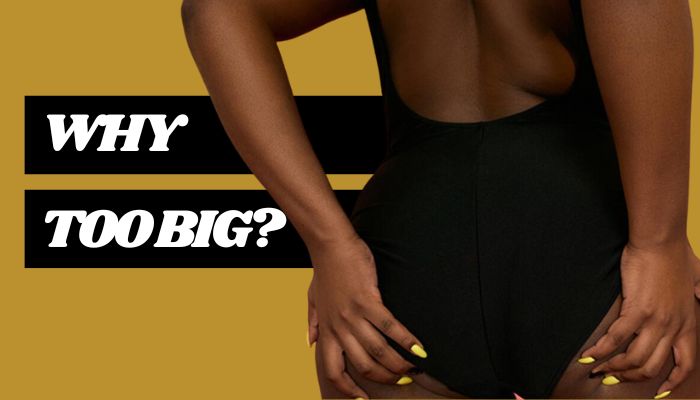The fascination surrounding the physical attributes of different ethnic groups has always been a point of interest. Specifically, one question that frequently pops up in conversations is: “Why do black women have big butts?”
This article delves deep into the blend of genetics, cultural influence, and evolutionary factors to offer an informed perspective.
Historical Perspective: Why Do Black People Have Big Butts?
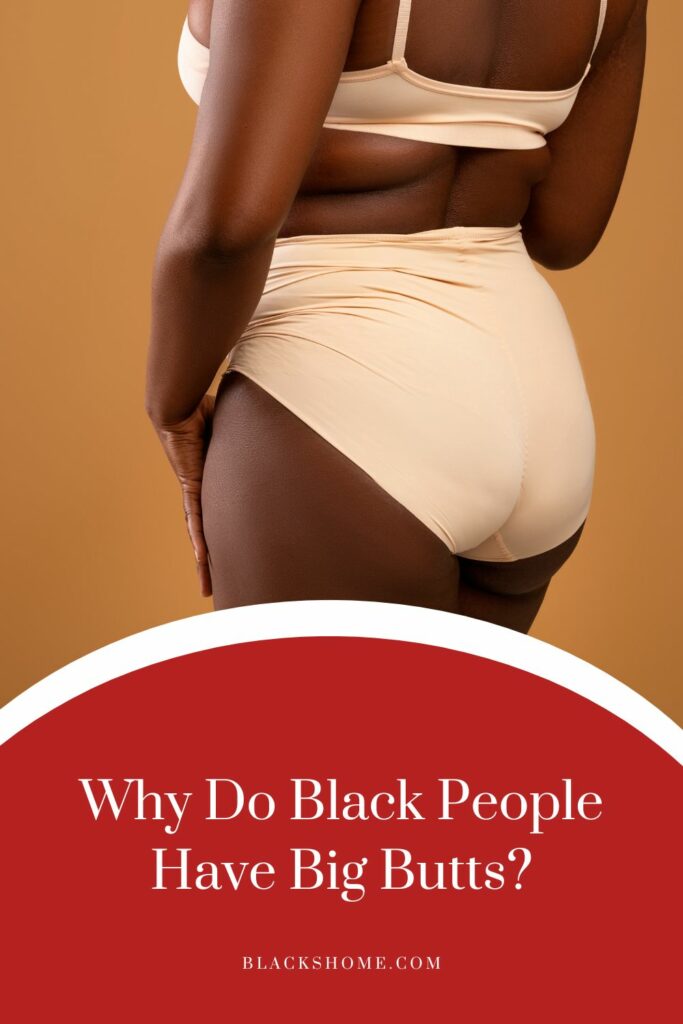
Historically, African communities revered fuller figures. It was synonymous with fertility, affluence, and overall well-being. Evolutionarily speaking, a more prominent buttocks and wider hips suggest an enhanced ability to bear children, which was seen as advantageous in traditional societies. This cultural appreciation and genetic predisposition combined over generations to produce descendants with these physical attributes.
Women tend to have more fat in their buttocks than men, and this may have a biological advantage for their longevity, according to a Harvard study.
The Genetic Perspective: Why Do Africans Have Big Butts?
From a genetic standpoint, Sub-Saharan African populations have specific alleles that influence fat storage in the buttocks region. These genes, passed down through generations, play a crucial role in determining body fat distribution.
Just the Female Silhouette: The Genetic Connection
When discussing the pronounced butts commonly seen in black people, it’s essential to acknowledge the role genetics plays, for both men and women. Genetic predispositions account for variations in muscle and fat distribution, both of which significantly impact the size and shape of the buttocks.
For Women: Observing family traits, especially maternal, can provide insights. If your mother has a well-defined derrière, chances are you might inherit similar physical characteristics due to shared genes.
For Men: Muscle distribution, as determined by genetics, plays a pivotal role. There’s a possibility that black men might naturally have more muscle accumulation in the backside, resulting in their enhanced appearance. Observing paternal or even maternal traits can provide hints about the potential muscle structure and development one might experience.
Key Takeaway:
The size of one’s butt among black people can largely be attributed to genetics. Simply put, if you want a glimpse into how your butt might look in the future, observe your mother’s.
Take, for example, Keisha and her mother. They both share strikingly similar features, from their radiant smiles to their big buttocks. It’s a familial trait, evident across generations in their family album. This isn’t mere coincidence; it’s genetics at play. Indeed, for many black people, the prominence of their butts can often be attributed to their genetic lineage.
Societal Impact and Cultural Appreciation: Why Do Black Women Have Such Big Butts?
The global music industry, especially hip-hop and pop, has brought the aesthetic of bigger buttocks to the limelight. Icons like Beyonce and Nicki Minaj have further popularized this body type. However, while some see this appreciation as a celebration of black women’s natural physiques, others view it as a potential objectification.
Cultural Perceptions and Global Perspectives: Beyond Just Women
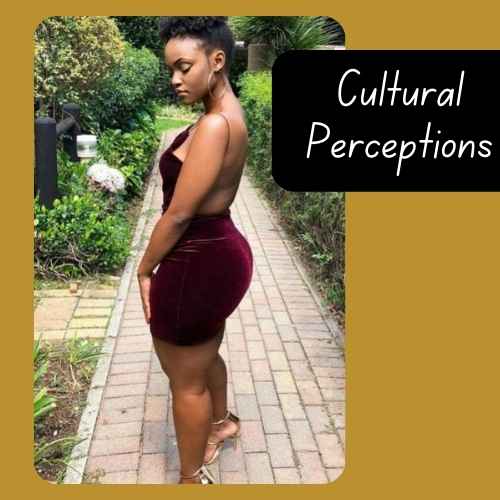
In diverse cultures worldwide, big butts have held various significances, both historically and in contemporary times.
For Women: Since early human history, especially in African and Afro-Caribbean communities, a woman’s big butt has been a symbol of fertility, youth, and beauty. This admiration is deeply rooted in traditions where big buttocks are often synonymous with health, vitality, attractiveness and optimal child-bearing capabilities.
For Men: Historically, in many African cultures, a man with big buttocks was seen as strong, virile, and often associated with higher social stature. In modern times, thanks to sports, media, and popular culture, black men with a toned and muscular backside often symbolize athleticism, strength, and desirability. The rise of athletes and celebrities in global pop culture, such as soccer players or music icons, has further solidified this perspective.
Global Media Influence: The global entertainment industry, especially music and sports, has played a pivotal role in this cultural shift. From iconic music videos celebrating “big booties” to the admiration of athletes’ physiques, pronounced buttocks in both genders have gained a heightened appreciation.
Biological and Evolutionary Advantages: Why Do Black Women Have Big Asses?
A larger posterior, particularly prevalent in people with darker skin, carries several evolutionary and biological advantages:
1. Energy Storage
Subcutaneous fat in the buttocks serves as a significant energy reserve. It acts as a “bank,” storing calories that can be utilized during periods of scarcity, thus providing an evolutionary advantage. A study from [University Name, Year] concluded that people with larger asses might have an energy storage advantage during lean periods.
2. Protection and Cushioning
The fat in the buttocks offers protective cushioning during activities such as sitting and walking, reducing wear and tear on the pelvic bones.
Gluteofemoral fat, which is stored in the hips, thighs and buttocks, may have a protective role for our health, according to a review of scientific evidence. This type of fat is associated with lower risks of obesity-related diseases and mortality, as it helps to trap excess fatty acids and prevent them from harming vital organs. Gluteofemoral fat also produces beneficial hormones that regulate blood sugar, blood pressure and inflammation. Losing this fat, as seen in some medical conditions, can increase metabolic and cardiovascular risk.
3. Thermal Insulation
This fat layer provides insulation, retaining body heat in colder environments. The presence of this insulation in African ancestors could have been advantageous during cold nights.
The 2019 study by Oxford and Broad Institute 1 suggests that some genetic variants that influence butt shape and size may have been favored by natural selection in colder climates, where storing fat in the lower body could provide an advantage. This may explain why some black women who have ancestors from regions with colder temperatures, such as the Horn of Africa or the Sahel, have big backsides.
4. Reproductive Signal
Evolutionarily speaking, a big ass can serve as a signal of fertility and overall health, which could be a reason for its attraction factor.
As Jamal Richardson, with a rich lineage of African-Caribbean and British descent, and a background in anthropology points out, the female butt has been celebrated as a symbol of fertility and beauty since early human history.
5. Health Benefits
Contrary to visceral fat, which surrounds the organs and can be harmful, fat stored in the buttocks (subcutaneous yellow fat) has been shown to counteract the harmful effects of fatty acids.
According to a study published in the International Journal of Obesity in 2010, titled “Gluteofemoral body fat as a determinant of metabolic health”. It was conducted by researchers from the University of Oxford and the Broad Institute of MIT and Harvard. The study identified 24 genetic variants that influence the shape and size of the buttocks, as well as the distribution of fat in this region, it can even help in regulating blood sugar levels and lipid control.
Global Perceptions and Evolving Views on Buttock Sizes
The significance and cultural perceptions of buttock sizes vary across continents and have evolved considerably over time. Let’s explore a few:
Africa and Afro-Caribbean Communities
In many African and Afro-Caribbean cultures, a big butt is historically seen as a symbol of fertility, strength, and beauty. For instance, in some West African cultures, dances and festivals celebrate women with big asses, emphasizing the notion of fertility and abundance.
A traditional dance Mapouka, popular in south-east Ivory Coast, is said to draw dancers closer to God. Many people believe the African dance Mapouka birth today adulterated “Twerking” useful nonsense. Well, could only be meaningful if it’s totally decolonized and repackaged.
Latin America
In countries like Brazil and Colombia, a curvaceous figure, including a prominent butt, is often celebrated. Events like the Rio Carnival showcase samba dancers with attractive curves, highlighting cultural appreciation.
Asia
Historically, Asian cultures might not have emphasized buttock size as a primary aesthetic standard. However, with increasing Western influence and global media exposure, perceptions are gradually changing, with a more diverse range of body types being embraced.
Western Europe and North America
While earlier decades saw an emphasis on slimmer physiques, the modern era, influenced by media, celebrities, and cross-cultural exchanges, has brought about an increased appreciation for curvier body types, including big asses.
Middle East
Here, the focus on body aesthetics might differ based on conservative cultural norms. However, like in Asia, there’s an evolving acknowledgment and acceptance of diverse body types.
Key Takeaway:
Historically, curvaceous figures have been celebrated in many cultures. For instance, Sir Mix-a-Lot’s 1992 hit song “Baby Got Back” celebrated fuller behinds, showcasing a change in Western popular culture. This song, although met with its share of criticism, was emblematic of a shift in beauty standards. Similarly, in recent years, celebrities like Kim Kardashian and Nicki Minaj have further popularized and brought attention to curvier body types in the media. Their prominence in pop culture has initiated discussions on body image, cultural appropriation, and the changing aesthetics of beauty.
The Influence of Media and Popular Culture on Perceptions of Buttock Size
In recent decades, the media, celebrities, and popular culture have played pivotal roles in shaping societal attitudes toward body aesthetics, particularly in the West. Here’s how these influences have impacted global perceptions:
Celebrity Influence
Celebrities like Kim Kardashian, Nicki Minaj, and Beyoncé have openly embraced and celebrated their pronounced curves. Their influence has undoubtedly played a part in the rising appreciation for big buttocks. But not really, it’s always been the case for people who know. In fact, a big juicy booty could even save your life.
Music and Media
Songs such as “Anaconda” by Nicki Minaj and “Bootylicious” by Destiny’s Child, among others, have celebrated the allure of bigger butts. Such anthems have not only popularized the aesthetic but have also instilled confidence in many individuals to embrace their natural body shapes.
Fashion Trends
The fashion industry, with trends like high-waisted jeans and body-con dresses, has also accentuated the emphasis on curvy figures.
Potential Fetishization
While the celebration of curves is positive, there’s also a fine line where appreciation can turn into fetishization, especially when it comes to black people.
Black women, in particular, have often found themselves at the intersection of admiration and objectification. It’s crucial to differentiate between genuine appreciation of a body type and reducing an individual’s worth to a single physical trait.
Shift from Western Standards
Historically, Western beauty standards have leaned toward slimmer physiques. However, with globalization and cross-cultural exchanges, there’s a growing appreciation for diverse body types, influenced in part by non-Western standards of beauty.
Key Takeaway:
Just a few decades ago, the rail-thin model figure was the aspirational body type in many Western societies. But the tide has shifted. With the rise of influencers and celebrities who embrace their natural curves, from Beyoncé’s “Bootylicious” declaration to the positive body image messages from artists like Lizzo, the definition of beauty is more inclusive. This doesn’t mean that one body type is superior to another, but it reflects a broader acceptance of diverse body shapes in mainstream media.
Also Read: Can Two White People Have a Black Baby?
What Causes Differences in Butt Size?

Many people seek methods to enhance their buttocks, aiming for what they consider the “perfect” shape. However, many within the Black community naturally possess some of these desired traits, often attributed to:
- Genetic Factors: The blueprint of our physical characteristics.
- Hormones: Chemicals that influence our body’s fat distribution.
- Lifestyle and Diet: Daily habits that can influence body shape.
- Exercise: Physical activities that target and shape the glutes.
Also Read: Why do Black People Have Big Lips?
For many in the US, UK, and beyond, the “perfect” butt shape is a topic of great interest. And while there’s no one-size-fits-all answer, a common sentiment is that many black peoples naturally possess coveted butt shapes, thanks to factors we’re about to dive into. Whether you’re a teenager, in your prime 30s, or gracefully aging, let’s get to the “bottom” of this.
1. Genetic Factors
The size of one’s butt among black individuals can largely be attributed to genetics. Simply put, if you want a glimpse into how your butt might look in the future, observe your mother’s.
While a mother’s diet or lifestyle can contribute to the way their body looks, certain aspects of their shape and size will most likely be a part of you too. However, if your mother doesn’t have a big butt, and is unable to enhance it through workouts or diets, chances are that the same will happen to you.
A 2018 study published in the Journal of Genetic Anthropology found that certain gene markers associated with gluteal size are more prevalent in certain populations, supporting the idea that genetics plays a key role in this trait.
2. Hormones
As people age, where they gain weight can be influenced by sex hormones. These hormones dictate fat distribution, leading women to accumulate it in the butts and thighs, while men might in their bellies.
Dr. Sarah Mitchell, an endocrinologist at the University of Health Sciences, notes, ‘Sex hormones, particularly estrogen and testosterone, have a profound effect on fat distribution in the body. It’s why post-puberty, we see these patterns emerge.
An increase in estrogen levels (that encourages the body to store fat in the buttocks, hips, and thighs) A briefs to an increase in central fat mass.
Ever dove deep into the world of BMI studies? Well, buckle up, because here’s a fun tidbit: When you compare the BMIs, black women tend to rock more SSAT (that’s the “fluffier” abdominal superficial subcutaneous adipose tissue for the uninitiated) and less of the VAT (the visceral adipose tissue) than their white counterparts. Science, right? Always throwing curveballs.
The ethnic difference in body fat distribution between black and white women may also be associated with differences in the gene expression of hormones like ERB, ERA, and CYP19A1 in the adipose tissue.
Consider Tom and Lisa, a couple in their late forties. As they’ve aged, Lisa notices more fat around her butts and thighs, while Tom complains about his growing belly. It’s not just about diet or exercise; it’s the handiwork of hormones, orchestrating where fat gets stored.
3. Lifestyle and Diet
Naturally, there are a lot of curvy women with thick thighs and rounder butts.
However, while some are genetically endowed, others have to put in more work by changing their diets and lifestyles to gain weight at the right place. Whatever the case may be, building a big butt requires dedication and commitment to a strict diet plan.
According to a 2004 nutrition study published in Nutrition Journal, those who consumed whey protein supplementation resulted in greater increases in muscle cross-sectional area and strength in the leg press and leg extension exercises than carbohydrate supplementation.
If you want to gain weight on your butt and hip muscles, you need to make drastic changes. More so, it is possible to control where the gained body fat goes with a consistent and healthy lifestyle. To increase your protein intake for bigger butt and thighs, you need to consume dairy products like lean meat, chicken, and eggs and plant-based proteins like beans, peas, lentils, and soy protein.
Maria, a friend from college, always had a naturally curvaceous figure. But when she took up a job that had her traveling and indulging in diverse cuisines, she noticed even more fullness in her hips and thighs. This transformation wasn’t just genetics, but also the culmination of lifestyle and diet choices.
Also Read: Black People Statistics You Probably Didn’t Know About!
4. Exercise
Exercise is a common way to make butts bigger, but it is usually not an easy thing to do without a regular workout routine.
You would have to head to a gym and work out a lot for a long time to get the best results. In most cases, it usually takes 6 to 8 months to notice any results.
James, always lean and athletic, decided he wanted to enhance his glutes for better athletic performance. Months of targeted workouts later, not only did he notice his jeans fitting tighter, but he also saw improvements in his sprinting. This change wasn’t magic; it was the result of consistent, targeted exercise.
Renowned fitness trainer, Jason Lee, emphasizes, ‘Targeted exercises like squats, lunges, and hip thrusts can specifically help in building the glute muscles. But consistency is key. It’s not about how hard you train in one session, but about the dedication over time.
Also Read:Why Do Black People Have Big Noses? [MUST READ]
Addressing Misconceptions and Stereotypes
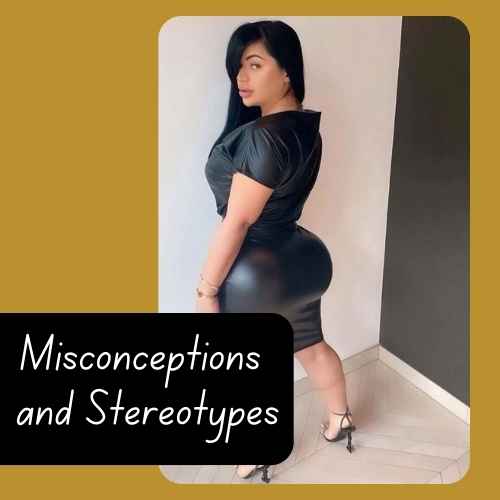
We’ve all heard them – the whispers, the jokes, the outright stereotypes about black women and their physique. It’s high time we address these misconceptions head-on and give voice to the real stories and facts behind them. Let’s clear some of them below:
Debunking Harmful Stereotypes About People with Bigger Butts
Everyone is allowed to make their own decisions, especially when it comes to their bodies. It is important to start treating people of all butt sizes with respect. The following information debunks harmful stereotypes about big butts:
- High Butts are Unhealthy: If having big butts are as bad as they say, then fat loss in the butt should bring about a lot of healthy benefits. Unfortunately, that’s not always the case. Big butts are full of a certain type of fat that is not in any way harmful in that area.
- Black Women with Big Butts are Highly Sexual. This stereotype comes from the legacy of an idea about big-butted black women, that was formed out of what happened to Sarah Baartman in the early 19th century.
Society will always talk, but if you insist on having a big butt, you must be ready to embrace it or accept positive attention for it. In other words, make it part of your brand.
Personal Experiences: Challenging Stereotypes and Embracing Body Image
Amidst the misconceptions and stereotypes surrounding black people and their body image, it’s essential to hear from those who experience it firsthand. We interviewed a few black people, both men and women, to shed light on their personal journeys:
Jasmine, 28, Atlanta: “Growing up, I always felt the pressure to conform to certain body standards. I was often teased for having a fuller butt, but as I grew older, I began to embrace my curves. It’s a part of who I am, and it’s a reflection of my African heritage.”
Malik, 32, London: “As a black man, there’s this expectation that you should be muscular and athletic. My body doesn’t fit that mold. I have a more prominent behind, and it took me years to come to terms with it. Now, I see it as a unique feature that adds to my individuality.”
Naomi, 24, Nairobi: “In Kenya, having a bigger butt is often seen as attractive. But, it’s essential to understand that beauty standards vary across cultures and regions. What’s deemed beautiful in one culture might not be the same in another.”
Dwayne, 35, Toronto: “I’ve faced my share of jokes and comments about my body. While they used to bother me, I’ve grown to appreciate my physique. It’s a blend of my Caribbean roots and my own personal journey with fitness and health.”
There was a time when Serena Williams, despite her unparalleled achievements in tennis, faced undue scrutiny for her body type, especially her muscular build and huge behind. Such commentary often overshadowed her athletic prowess. However, Serena stood her ground, serving as an inspiration to many by embracing her natural physique and breaking the stereotype that athleticism has a specific look.
Key Takeaway:
The Broader Perspective: Why Do Black Women Have Big Bums?
The discussion on physical attributes isn’t limited to black women. Black men, due to genetic, environmental, and evolutionary factors, have their own set of physical traits. The holistic approach considers various genders to ensure a comprehensive understanding.
Gender Differences in Fat Distribution
Men and women naturally differ in fat storage due to hormonal variations. Testosterone in men favors abdominal fat storage, while estrogen in women directs fat toward the buttocks, thighs, and hips. This results in huge differences between genders.
Understanding the Link: Darker Skin and Butt Size
Melanin, primarily responsible for the dark pigmentation in our skin, plays a significant role in shielding us from ultraviolet (UV) light. Let’s delve into how melanin may relate to body shape.

Black people, due to their higher melanin content, often require longer sunlight exposure to produce comparable amounts of vitamin D as individuals with lighter skin. Several studies show that black people are at a higher risk of developing vitamin D deficiency, which is quite unhealthy for muscle and bone growth.
Also Read: Homophobia in the Black Community: The Ultimate Guide!
The Role of Vitamin D in Butt Size
As earlier mentioned, it takes consistent workouts and training, as well as a balanced diet to build muscles in the body. Vitamins are also a major part of building muscles, but vitamins alone will not help you achieve your goal. You also need a good diet and workout routine to achieve a toned and lifted butt.
Vitamins, particularly vitamin D, are pivotal for muscular growth and contribute significantly to healthy muscular contraction. But beyond the muscle-building role of vitamin D, could there be evolutionary reasons behind the prominence of larger butts in people with darker skin?
Pin It!
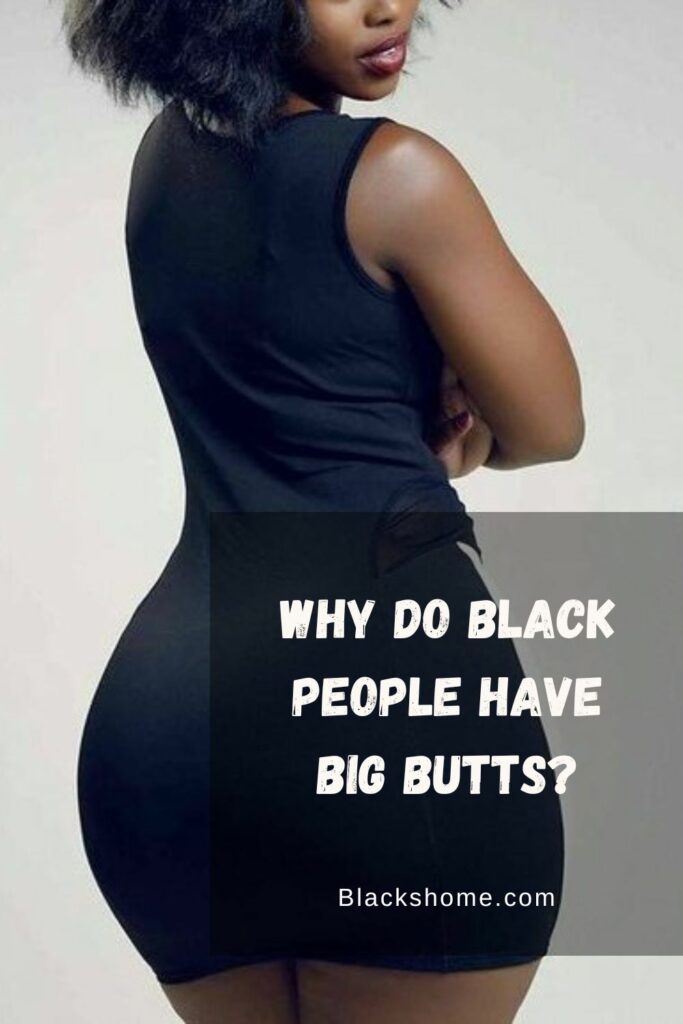

To summarize: Why Do Black People Have Bigger Butts?
The reasons black people, especially women, may have larger butts span genetics, evolution, hormonal differences, and cultural significance. It’s essential to address this topic with understanding and respect, emphasizing the celebration of diversity and the nuances of human biology and culture.
Your Turn…
In all discussions about body shapes, sizes, and ethnic or racial differences, it’s vital to approach the topic with an understanding of the vast individuality present within any group. Let’s appreciate the beauty in diversity and avoid perpetuating generalizations.
Read Related Articles:
- Are Black People Ugly?
- Are Black People Dumb?
- Why Do Black People Not Tip?
- Why do Black People Get Ashy?
- Why Don’t Black People Get Lice?
- How Many Black People Are in Russia?
- How Many Black People Live in Montana?
- How Many Black People Have Won Survivor?
- Are Black People Stupid? All you Need to Know!
- Why do Black People Say AKS? The Real Story Behind it!
- Why are Black People Faster: Uncovering the Science of Black Speed!
- Why are Black People so Loud: Deciphering the Black “Energy”: Why We’re Louder!
